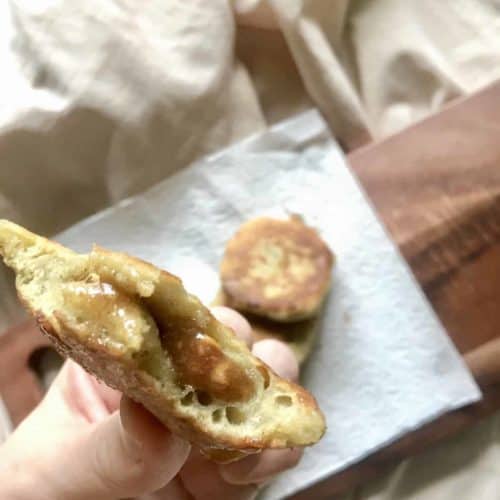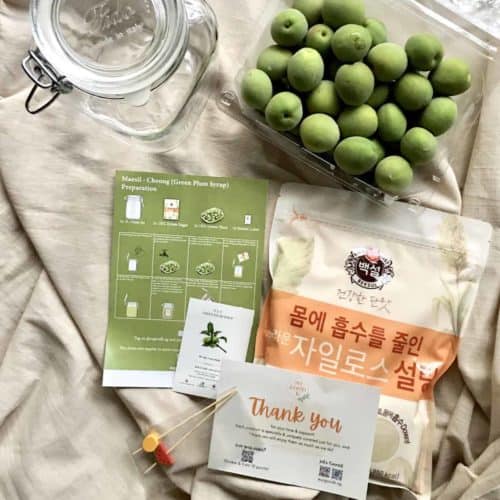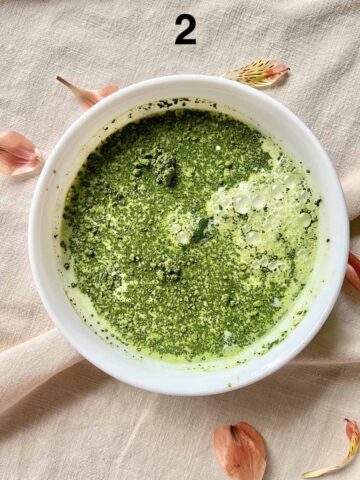Yuzu Tea, or Korean Honey Citron tea/ Yuza Tea/ Korean Yuja Cha, is a delicious, refreshing citron tea with a unique flavor. As yuzu can be difficult to find (and expensive!), I've shown you how to make it with fresh yuzu fruit as well as from yuzu concentrate and citrus substitutes.

Jump to:
⭐ Why This Recipe is a Star
- Simple: this Yuzu Tea 柚子茶 (Yuja Tea 유자차 or Korean Honey Citron Tea) is so easy, it's a 1-step, 2-ingredient recipe! You can make it with fresh yuzu/ fresh yuja fruit as well as yuzu concentrate.
- Delicious: yuzu has a very unique flavor- tangy, sweet and with bittersweet undertones; tart but aromatic.
- Good for you: this citron tea is full of Vitamin C! Over 2 times the amount a lemon contains, in fact! The syrup, which I show you how to make, can be used for yuzu jelly and yuzu mayonnaise.
Word of warning: fresh yuzu isn't cheap, even in Asia! To get a green yuzu in 2023 in Singapore, I have to pay about $12 per fruit whilst a 100g packet of yuzu zest is about $14. In the U.S., your best bet is a specialty Korean or Japanese grocer. (Yuzu imports are banned but there are US growers in California.)
Honestly, if you have a garden (and the right climate), I recommend growing it yourself. But keep in mind that it can take up to a decade to see the 1st flower!
What is Yuzu?
Also known as Yuja fruit in Korean, Yuzu is a type of Asian citrus. Despite being more commonly associated with Korea and Japan today, it's believed to have originated in China. They are very fragrant and retain their aroma at high temperatures, unlike other citrus.
You can find it in everything from Yuzu Matcha to Yuzu Liquer, cocktails, toast, ice cream, Yuzu Kosho and Yuzu Ponzu sauce. In fact, I just had a Yuzu cheesecake last week! (The acidity brightens the heaviness of the cream cheese.)
It has a characteristic bumpy skin- but not as wrinkly as a kaffir lime- and comes in several colors, ranging from yellow-green to orange. (Don't use green yuzu for the tea as the skin is too hard.) The pulp is quite dry, so the fruit isn't usually eaten alone. Usually, the zest is used.
I'll show you how to make yuja-cheong, or yuzu syrup, from the fresh fruit. The process is very similar to making Korean plum syrup and tangerine-cheong.
However, fresh yellow yuzu is only available around November and December- and is hard to find. (You can get green yuzu at other times of the year and may be able to find the frozen product- usually in a puree- if your market is well stocked.)
Hence, I've also shown you how to make the citrus tea using shop-bought yuzu marmalade -You can find this thick syrup in Asian grocery stores, Korean markets or Japanese stores- and suggested some substitutes if you want to make the syrup yourself.
Fun fact: 柚子 actually means "pomelo" in Chinese (a different fruit), so don't get confused!
🥘 Ingredients
If using shop-bought yuzu cheong, you only need 2 ingredients for the tea.
- yuzu syrup concentrate: these are sold in glass jars online or at the Asian grocery store. You want to spoon in the rinds too.
- hot water
To make your own yuzu concentrate, you'll need:
- yuzu citrus fruit: sliced thinly, removing the seeds. (If a couple get away from you, don't sweat it.) Look for yuzu fruits that are firm, brightly colored, and fragrant. The skin should be free from blemishes. If you make the tea with fresh fruit, you can eat all of it, the flesh and the peel (minus the seeds, of course!) The fruit is quite dry so you don't have to worry about "wasting" the juice when slicing. It's related to Mandarin Orange but tastes more like grapefruit. If you can't get it, I suggest mixing Meyer lemons with grapefruit and just a pinch of Mandarin Orange. Add a bit of the pith to mimic the bitter undertones of yuzu (but not too much!)
- honey: traditional sweetener for Korean Yuja Cha (the Japanese use rock sugar, which lets the yuzu fragrance shine better; you can use a mix of honey and sugar, in a 1:1 ratio.) You need a very neutral honey if not the yuzu flavor is overpowered. Regular sugar turns the fruit into syrup more quicker but rock sugar has more aroma.
🔪 Step-by-Step Instructions
Making the Yuzu Syrup
Optional: like with my maesil, I like to soak the yuzu fruit in baking soda to remove pesticides. Rinse well after then dry carefully. Remove any brown pieces of skin.
- Cut the fruit in half, then half again (i.e. you get 4 quarters.)
- Julienne the peels, removing the seeds and the pith (the latter will make the tea too bitter.) Keep any juice that runs out- it can be used when cooking seafood.
- Blend the pulp and the juice.
- In a sterilised glass jar, layer the peel followed by a layer of honey/ sugar- you will need equal amounts of the two- then another layer of yuzu etc till the jar is full. (Make sure the top layer is sugar/ honey so no fruit is exposed.)
- Leave out for 1 day: it can take longer if you make a big batch. (My tangerine-cheong barely dissolved after 1 day in the tropics!
- Stir every day with a sterilized dry spoon till dissolved- then store in the fridge.
- You can eat it immediately but the flavor won't have fully developed. I suggest waiting at least 10 days.
Note: if using rock sugar, it will take about 2 weeks at room temeperature to "dissolve."
Turning the Syrup into Tea

- Scoop at least 1 Tablespoon per cup of hot water, use the pulp too. Stir, mix well, and enjoy.
🥡 How to Store
Keep the syrup in the fridge in an airtight container. It should last 1-2 months if your glass jar has been sterilized properly.
The drink can be stored in the fridge for 1-2 days.
👩🏻🍳 Expert Tips
Tip #1: Mix with cold sparkling water for yuzu soda.
💭 Recipe FAQs
It contains Vitamin C and is good for the immune system. Like barley tea and plum tea, this herbal tea has no caffeine and is a nice hot beverage for winter or for when you're feeling under the weather. (It's actually a traditional Korean tea for colds and flus.)
Note: you can mix yuzu with green tea or black tea if you want a pick-me-up though!

🥗 Other Korean Recipes
Enjoyed this easy Yuzu Tea Recipe? Please leave a 5-star 🌟🌟🌟🌟🌟rating in the recipe card below! If you REALLY like Korean herbal blends, please consider supporting it by buying me a coffee! 🙂 (No obligation though!) Thank you and have a great day!

Yuzu Tea (Korean Yuja Cha)
Equipment
- Sterilized glass jar
- Knife and cutting board
Ingredients
For the Yuzu Tea
- 1 Tablespoon Yuzu syrup Shop-bought or homemade. See below for what you need to make yuzu cheong at home.
- 1 Cup Water
For homemade Yuzu Syrup
- 1 Cup fresh yuzu
- 1 Cup Honey Use a neutral honey if you prefer Korean style, rock sugar if you want Japanese yuzu tea, or regular sugar for a quicker syrup.
Instructions
To make the yuzu fruit syrup
- Optional: like with my maesil, I like to soak the yuzu fruit in baking soda to remove pesticides. Rinse well after then dry carefully. Remove any brown pieces of skin.
- Cut the fruit in half, then half again (i.e. you get 4 quarters.)
- Julienne the peels, removing the seeds and the pith (the latter will make the tea too bitter.) Keep any juice that runs out.
- Blend the pulp and the juice.In a sterilised glass jar, layer the peel followed by a layer of honey/ sugar- you will need equal amounts of the two- then another layer of yuzu etc till the jar is full. Note: Make sure the top layer is sugar/ honey so no fruit is exposed.
- Leave out for 1 day: it can take longer if you make a big batch.
- Stir every day with a sterilized dry spoon till dissolved- then store in the fridge.You can eat it immediately but the flavor won't have fully developed. I suggest waiting at least 10 days. Note: if using rock sugar, it will take about 2 weeks at room temeperature to "dissolve."
To make yuzu tea
- Combine at least 1 Tablespoon of yuzu cheong (including the bits of fruit) with 1 Cup of water, sitrring well.
Notes
Note: the nutritional information is an estimate automatically calculated using the WPRM recipe maker and I am not responsible for its veracity.
Nutrition
If this Asian tea recipe was helpful, maybe you'd like to sign up for my newsletter in which I send you more tips and tricks to make authentic Asian food?










Comments
No Comments